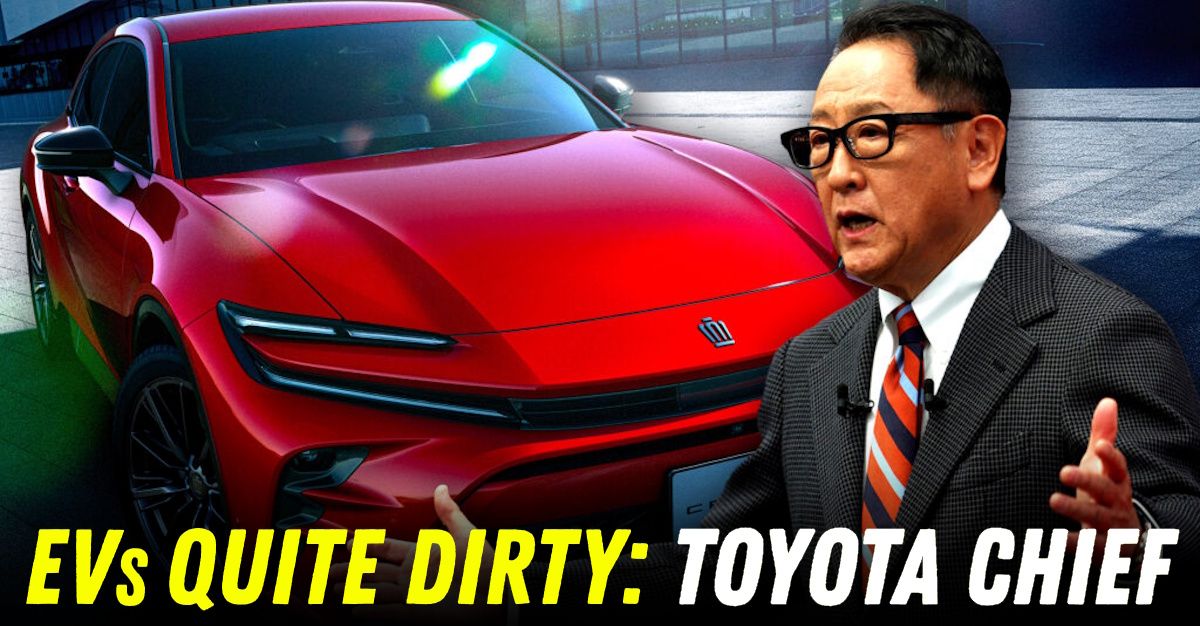Electric Cars Are A Lot Dirtier Than You Think, Says Toyota Chief


When a company like Toyota, often seen as a pioneer in green mobility, questions the environmental credentials of electric vehicles, it’s bound to spark global debate. Akio Toyoda, chairman of Toyota and a staunch advocate of hybrid technology, has once again stirred the conversation by saying EVs might be “dirtier than you think.” His comments challenge the dominant narrative that battery electric vehicles (BEVs) are the cleanest and most sustainable path forward.
While EVs have become a symbol of clean innovation, Toyoda argues that the reality is far more layered - and often less green than advertised.
At first glance, electric vehicles look like the perfect solution to carbon emissions. They produce no tailpipe emissions, run silently, and promise a future free of fossil fuels. But Toyoda is quick to remind the world that the true environmental cost of an EV lies far beyond what’s seen on the road.
A significant part of this cost comes from battery production. Mining for essential minerals like lithium, cobalt, and nickel is resource-intensive, damaging to ecosystems, and highly polluting in many parts of the world. These materials often travel thousands of kilometres from mines to processing centres to assembly lines, leaving behind a sizeable carbon trail.
Then there’s the issue of electricity. An EV’s carbon footprint depends heavily on how the electricity used to charge it is generated. In countries or regions still reliant on coal or gas for power, the emissions associated with charging an EV can offset many of its green benefits. Toyoda cited Japan as an example, where a rise in EV usage might paradoxically lead to higher overall emissions due to the dominance of thermal power plants.
Toyota’s long-standing emphasis on hybrid vehicles is central to this debate. The company introduced the Prius nearly three decades ago, and since then has sold around 27 million hybrids worldwide. Toyoda claims that these hybrids have delivered carbon savings comparable to 9 million BEVs - but without the heavy demand on rare earth metals or grid infrastructure.
Hybrids offer a balance. They still use petrol but pair it with electric motors to boost fuel efficiency and reduce emissions. Crucially, they don’t require charging infrastructure - a significant advantage in many developing or infrastructure-deficient regions.
This “middle path” makes hybrids more practical and scalable in the near term, particularly where charging stations are scarce or where the electricity grid is far from clean.
Toyoda’s larger argument isn’t anti-EV. It’s pro-diversity. He advocates for a multi-path approach to carbon neutrality - where hybrids, plug-in hybrids, hydrogen-powered vehicles, and BEVs coexist. According to him, a single-minded push for EVs overlooks regional realities: infrastructure readiness, energy sources, consumer affordability, and environmental trade-offs.
This view has its critics. Some accuse Toyota of dragging its feet on electrification. Others say the company risks falling behind in the global EV race. But Toyoda remains clear - the mission is not to sell a specific technology, but to lower carbon emissions in the most effective, practical way possible.
India offers a perfect case study for Toyoda’s multi-pathway thesis. Despite aggressive EV targets and policy incentives, the country still faces challenges: limited public charging infrastructure, high battery import dependence, and a power grid that’s still significantly coal-based.
Toyota India’s current portfolio reflects this pragmatic view. The company has steered clear of full EVs so far. Instead, it focuses on strong hybrids - like the Urban Cruiser Hyryder and the Innova Hycross. Both models use self-charging hybrid systems, reducing fuel consumption by up to 40% and offering practical emissions savings without the need for charging stations.
This approach aligns neatly with Toyoda’s argument: in markets like India, where infrastructure and affordability are critical, hybrids may offer faster, more impactful carbon reduction than full EVs in the short term.
As countries chase carbon neutrality and automakers roll out new technologies, Akio Toyoda’s comments serve as a reminder: the cleanest solution isn’t always the most obvious. EVs are part of the puzzle - but not the whole picture. In many parts of the world, including India, hybrid technology may well be the bridge we need before full electrification becomes truly clean, affordable, and sustainable.
By looking beyond headlines and examining the full lifecycle of vehicles - from raw material extraction to end-of-life - we might just find that the best path to a cleaner future is not one road, but many.
Via CarScoops